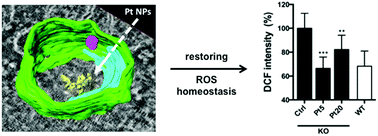Platinum nanozymes recover cellular ROS homeostasis in an oxidative stress-mediated disease model†
Abstract
In recent years, the use of nanomaterials as biomimetic enzymes has attracted great interest. In this work, we show the potential of biocompatible platinum nanoparticles (Pt NPs) as antioxidant nanozymes, which combine abundant cellular internalization and efficient scavenging activity of cellular reactive oxygen species (ROS), thus simultaneously integrating the functions of nanocarriers and antioxidant drugs. Careful toxicity assessment and intracellular tracking of Pt NPs proved their cytocompatibility and high cellular uptake, with compartmentalization within the endo/lysosomal vesicles. We have demonstrated that Pt NPs possess strong and broad antioxidant properties, acting as superoxide dismutase, catalase, and peroxidase enzymes, with similar or even superior performance than natural enzymes, along with higher adaptability to the changes in environmental conditions. We then exploited their potent activity as radical scavenging materials in a cellular model of an oxidative stress-related disorder, namely human Cerebral Cavernous Malformation (CCM) disease, which is associated with a significant increase in intracellular ROS levels. Noteworthily, we found that Pt nanozymes can efficiently reduce ROS levels, completely restoring the cellular physiological homeostasis.


 Please wait while we load your content...
Please wait while we load your content...